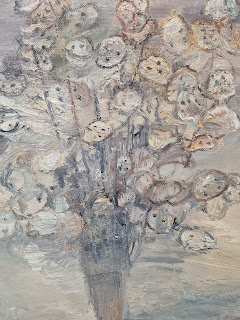An empty chair in an anonymous room, placed in a void, with no identifying features whatsoever. It's an image of loneliness (and one worthy of Edward Hopper), an image of sadness, and, more than anything, an image of loss.
My Chair (3) (2020)
Or at least that's how it seemed to me when, on a gorgeously sunny Saturday, I headed down to the Victoria Miro Gallery on Wharf Road to check out Celia Paul's Memory and Desire. Other than staff, there was only one other visitor in the cavernous gallery space and that's understandable. People were making use of the sunshine to sit in parks and beer gardens and soon enough I would join them.
The large empty room gave a strange atmosphere to an exhibition that very much made me think of a funeral. Or, at least, a wake. There were lots of flowers and lots of sad looking ladies in dark dresses painted in muted colours against grey or brown backgrounds. If you're a fan of 'mud colours' then Celia Paul is the artist for you.
Self-Portrait, April 2020 (2020)
Self-Portrait, February 2022 (2022)
Self-Portrait, April 2021 (2021)
There were some abstract works too, and some boats set against seas that rendered them helplessly small, but what there wasn't was any information whatsoever. Or names for the individual paintings (I was able to find some on the Internet afterwards and have included them where possible). So, I took them all as one large piece. A piece that suggested, and further research proved me correct on this, that Celia Paul had recently suffered a significant loss.
Or maybe more than one. The sitters in the painting aren't always Paul (though they quite often are) but they look a bit like her because they are her sisters and those sisters have shared in the loss of not one but two parents. Wandering around the Victoria Miro on Saturday, you almost felt like you'd been tasked with clearing out a dead person's house. Removing all the seemingly random sundries that tell the story of a life that is no longer being lived.
Dieppe (2021)
My Mother and the Mountain (1994-2020)
At times it almost felt eerie. But, at the same time, it was presented with the grace of a swan on a river or a rowing boat in front of a huge iceberg. The enormity of life towers above us as it does these paintings. Paintings that show impressionistic birds floating in thickly painted skies. Or, possibly, vultures circling and ready to feed on our remains.
In many ways, Memory and Desire was a continuation of Celia Paul's last show here back at the start of 2020 but there's been a pandemic since then and all of us, or at least most of us, have come to look at death in a slightly different way. Some of these paintings were made before the pandemic, some during it, and some after (I know Covid is still here but the pandemic phase, I hope and feel, is no more) but that's not really important. Death always looms.
Blue Bed (2021)
It looms in the form of empty beds, the grave decoration of flowers, and in the minds of the living. Celia Paul has long been inspired by Gwen John and this exhibition was put together in tandem with a book, by Jonathan Cape, in which Paul writes a series of imaginary letters to Gwen John who died in 1939, twenty years before Celia Paul was born.
In these letters Paul talks about the loss of both her parents, working in isolation conditions during lockdown, and losing her husband Steven - her sole companion during lockdown - on the 29th March 2021. It was a cruel irony that this should also be the day that lockdown restrictions began to be slowly lifted.
Daffodils (2022)
When Gwen John learned she was dying, she travelled from Paris to Dieppe because she wanted to see the sea for one last time. Celia Paul's landscapes are of places she and Steven had visited in their life together. The landscapes are imbued with meaning, with memory, and, now, an almost exquisitely painful sense of loss.
The use of blue, of course, fills the paintings with a sense of longing but they also rhyme with Gwen John's desire to stare out, one last time, at the vast blue of the sea. Celia Paul lives in Bloomsbury, she can see the British Museum from her window, so it seems safe to assume that the painting below is one of the BT Tower and, bearing in mind she had a relationship with him, it's probably safe to assume that the figure embracing her in the image below is that of Lucian Freud.
My Father's House (2020)
The Path Home (2020)
Kate in Red (2021)
Not least because it looks like him! These paintings are documents of not just one life fully lived, but several lives fully lived. But the thing with living one's life to the full is that you want to carry on doing that. Our bodies, of course, have different ideas. They slow down, they start to fail us, and, eventually, they stop working altogether.
I find Celia Paul's reflections on mortality to be really quite beautiful and they chime with the fact that I have thought a lot about my own mortality of late. But, and I imagine Celia Paul feels the same, I'm not ready to go yet. There are things I want to do, places I want to go, and people I want to spend more time with.



























No comments:
Post a Comment